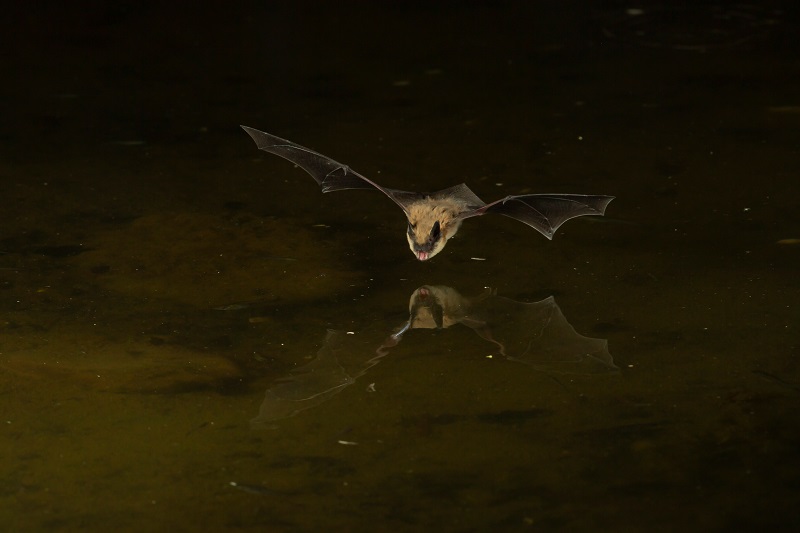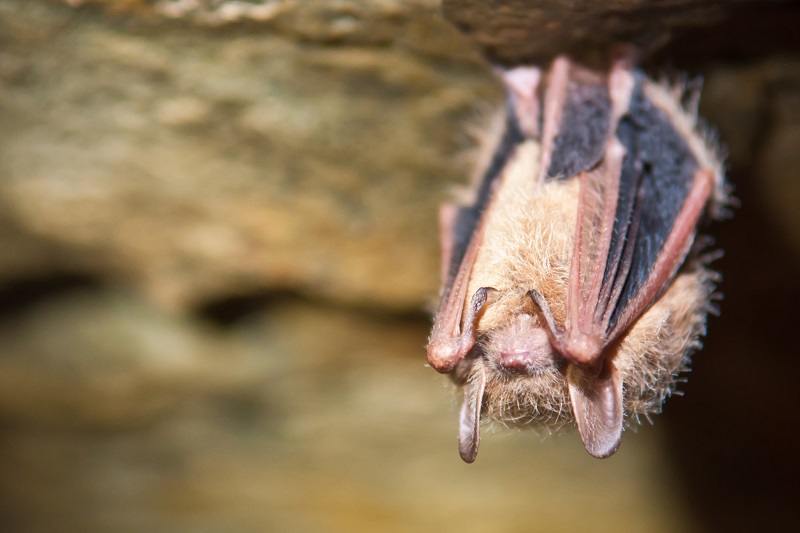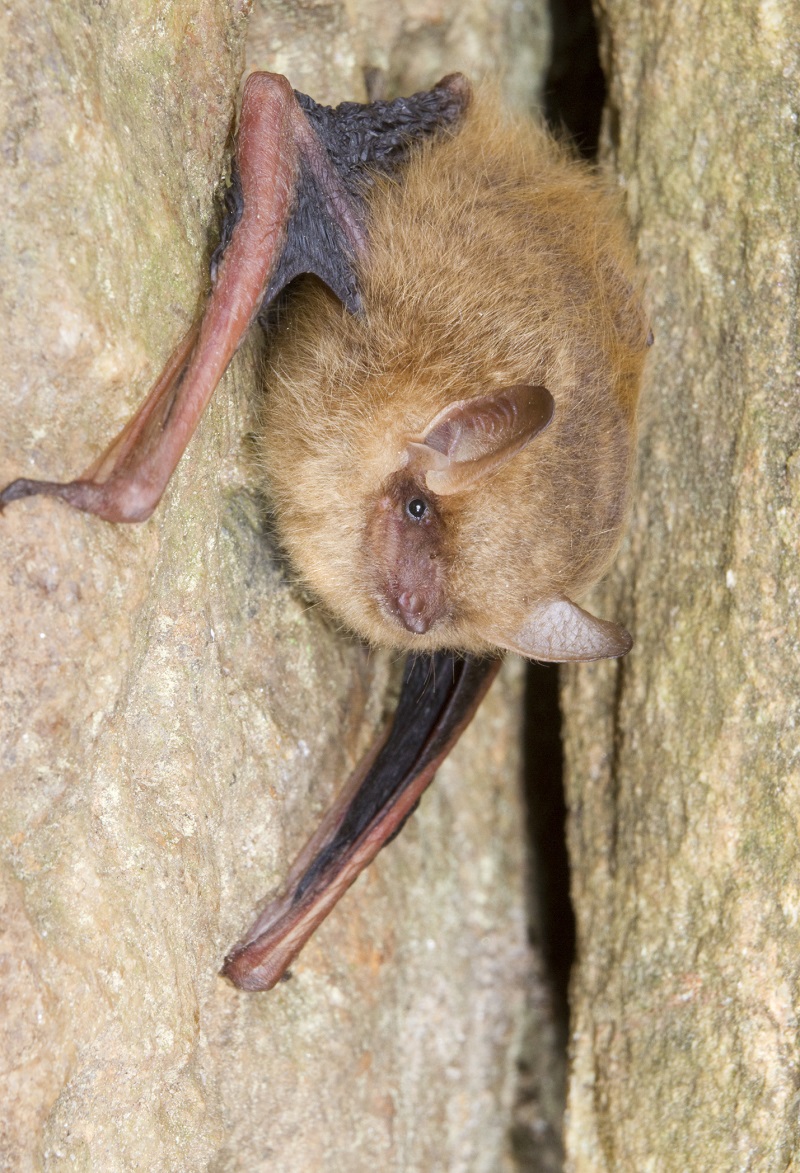
 WildlifeNYC311
WildlifeNYC311 Search all NYC.gov websites
Search all NYC.gov websites
Bats
Bats

A big brown bat (Eptesicus fuscus) mid-flight.
Introduction
They operate under cover of darkness. Armed with the power of flight and extraordinary hearing, they move quickly and stealthily. They mostly go unnoticed, but on summer nights, high above our heads, groups of them swoop through the air to vanquish those looking to do New Yorkers harm.
No, this isn’t a team of crime-fighting superheroes we’re talking about—it’s New York City’s bats! Few New Yorkers realize it, but the city is home to a variety of these caped crusaders. Species found here include tree bats like eastern red bats (Lasiurus borealis) and hoary bats (Aeorestes cinereus) that migrate each year. Cave bats, including little brown bats (Myotis lucifugus), big brown bats (Lasiurus borealis), and tri-colored bats (Perimyotis subflavus) live here year-round. During warmer months our local bats feed on a variety of pesky insects, including mosquitoes, helping spare New Yorkers from their bites. But how do they survive here in the city, and what boroughs do they call home?

A tri-colored bat (Perimyotis subflavus) hanging upside down.
General Information
Background
Nine bat species can be found in New York State. Six of those species are cave bats who hibernate during the winter, and the other three species are tree bats that migrate to warmer areas when it gets cold. Bats can be found in all five boroughs of the city. According to a 2016 study by Fordham University and the Wildlife Conservation Society, five bat species have been observed in the Bronx alone. Several species are also known to live in Manhattan’s Central Park and Staten Island’s Freshkills Park.
Though they fly like birds, bats are actually mammals. In fact, bats are the only mammal capable of true flight. Unlike birds, bats give birth to live young and nurse their babies with milk—just like humans. Their wings also share many similarities with the human hand, featuring four fingers and a thumb.
Appearance
The bat species found in New York come in a variety of colors. Most have brownish and/or grayish fur, though some species appear black, yellowish, or reddish-orange. Cave bats usually lack fur around the skin that connects their tails to their legs. Tree bats have fur on those areas of skin, which they can gather around themselves for warmth.
Their wingspans can extend from 8 to 16 inches wide, with hoary bats being the largest and little brown bats being the smallest. Their body lengths are typically between 2 inches and 3.5 inches. Leathery skin connects all their fingers and comprises their wings. Their ears are very large in proportion to their heads. Bats also feature sharp teeth, which they use to cut through the hard exoskeletons of the insects they eat.
Behavior
Bats are nocturnal, so they typically feed at night and sleep during the day. Because they are most active at night, they depend on “echolocation” to navigate and locate prey in the dark. To echolocate, a bat emits short, high-pitched calls that are outside the range of human hearing. When these calls bounce off an object, bats can hear the echo using their extraordinary sense of hearing. Bats can almost instantly analyze the echo to determine exactly where the object is and what it looks like. Contrary to popular belief, bats can actually see quite well with their eyes—echolocation just helps make their flying and hunting skills even more precise.
The place where bats live is called a roost. For cave bats, roosts usually take the form of caves and mines in the winter, which is when they hibernate. Since caves and mines are in short supply in NYC, cave bats will oftentimes roost inside, outside, or under urban structures, including buildings. During the summer, their roosts include bridges, buildings, and crevices in rocks and trees. Tree bats, true to their name, typically roost in trees year-round, migrating south in the winter and returning north around mid-April. Roosts are typically occupied by groups of bats. Sometimes, groups of females have separate nursery roosts while they give birth.
Bats breed primarily in mid-to-late fall. However, females will store sperm from mating season until spring before fertilizing their eggs. Depending on the species, gestation can take between 40 and 60 days. Young bats are born in June and early July, and can usually fly and hunt within a month of being born.
Dracula may have given them a bad reputation, but New York bat species are not out for blood--they feed primarily on insects. That said, bats can carry and transmit rabies. If you come in close contact with a bat, even if you don’t believe you’ve been bitten, seek out medical attention.

A tri-colored bat resting in a crevice.
Fast Facts
• Bats can consume 20–50% of their body weight in insects every night.
• Bats can live very long lives compared to other mammals their size. The oldest recorded bat found in New York was 34 years old.
• Hibernating bats can slow their heart rates from over 200 beats per minutes to just 10 beats per minute, and can go minutes without taking a breath.

A big brown bat (Eptesicus fuscus) mid-flight.
Introduction
They operate under cover of darkness. Armed with the power of flight and extraordinary hearing, they move quickly and stealthily. They mostly go unnoticed, but on summer nights, high above our heads, groups of them swoop through the air to vanquish those looking to do New Yorkers harm.
No, this isn’t a team of crime-fighting superheroes we’re talking about—it’s New York City’s bats! Few New Yorkers realize it, but the city is home to a variety of these caped crusaders. Species found here include tree bats like eastern red bats (Lasiurus borealis) and hoary bats (Aeorestes cinereus) that migrate each year. Cave bats, including little brown bats (Myotis lucifugus), big brown bats (Lasiurus borealis), and tri-colored bats (Perimyotis subflavus) live here year-round. During warmer months our local bats feed on a variety of pesky insects, including mosquitoes, helping spare New Yorkers from their bites. But how do they survive here in the city, and what boroughs do they call home?

A tri-colored bat (Perimyotis subflavus) hanging upside down.
General Information
Background
Nine bat species can be found in New York State. Six of those species are cave bats who hibernate during the winter, and the other three species are tree bats that migrate to warmer areas when it gets cold. Bats can be found in all five boroughs of the city. According to a 2016 study by Fordham University and the Wildlife Conservation Society, five bat species have been observed in the Bronx alone. Several species are also known to live in Manhattan’s Central Park and Staten Island’s Freshkills Park.
Though they fly like birds, bats are actually mammals. In fact, bats are the only mammal capable of true flight. Unlike birds, bats give birth to live young and nurse their babies with milk—just like humans. Their wings also share many similarities with the human hand, featuring four fingers and a thumb.
Appearance
The bat species found in New York come in a variety of colors. Most have brownish and/or grayish fur, though some species appear black, yellowish, or reddish-orange. Cave bats usually lack fur around the skin that connects their tails to their legs. Tree bats have fur on those areas of skin, which they can gather around themselves for warmth.
Their wingspans can extend from 8 to 16 inches wide, with hoary bats being the largest and little brown bats being the smallest. Their body lengths are typically between 2 inches and 3.5 inches. Leathery skin connects all their fingers and comprises their wings. Their ears are very large in proportion to their heads. Bats also feature sharp teeth, which they use to cut through the hard exoskeletons of the insects they eat.
Behavior
Bats are nocturnal, so they typically feed at night and sleep during the day. Because they are most active at night, they depend on “echolocation” to navigate and locate prey in the dark. To echolocate, a bat emits short, high-pitched calls that are outside the range of human hearing. When these calls bounce off an object, bats can hear the echo using their extraordinary sense of hearing. Bats can almost instantly analyze the echo to determine exactly where the object is and what it looks like. Contrary to popular belief, bats can actually see quite well with their eyes—echolocation just helps make their flying and hunting skills even more precise.
The place where bats live is called a roost. For cave bats, roosts usually take the form of caves and mines in the winter, which is when they hibernate. Since caves and mines are in short supply in NYC, cave bats will oftentimes roost inside, outside, or under urban structures, including buildings. During the summer, their roosts include bridges, buildings, and crevices in rocks and trees. Tree bats, true to their name, typically roost in trees year-round, migrating south in the winter and returning north around mid-April. Roosts are typically occupied by groups of bats. Sometimes, groups of females have separate nursery roosts while they give birth.
Bats breed primarily in mid-to-late fall. However, females will store sperm from mating season until spring before fertilizing their eggs. Depending on the species, gestation can take between 40 and 60 days. Young bats are born in June and early July, and can usually fly and hunt within a month of being born.
Dracula may have given them a bad reputation, but New York bat species are not out for blood--they feed primarily on insects. That said, bats can carry and transmit rabies. If you come in close contact with a bat, even if you don’t believe you’ve been bitten, seek out medical attention.

A tri-colored bat resting in a crevice.
Fast Facts
• Bats can consume 20–50% of their body weight in insects every night.
• Bats can live very long lives compared to other mammals their size. The oldest recorded bat found in New York was 34 years old.
• Hibernating bats can slow their heart rates from over 200 beats per minutes to just 10 beats per minute, and can go minutes without taking a breath.
Coexisting with Bats in NYC
• Seal openings in homes and buildings. Bats have been known to roost inside buildings, under roofs, and in other small, enclosed spaces. To prevent bats from taking up residence in your home or building, seal any openings that they might be able to enter through.
• Observe bats from a distance. Beginning around dusk, bats can often be seen flying over open fields, bodies of water, and between trees as they hunt for insects. For your safety, always observe bats from a distance and do not attempt to touch or feed them.
• If you or a pet come in close contact with a bat, seek medical attention. The incidence of bat bites in NYC is small. However, bats can carry and transmit rabies, and their teeth are so small that bites can sometimes go unnoticed. If you or a pet have a close encounter with a bat, or you find them in your home, seek medical attention, even if you don’t believe that a scratch or bite took place. If you or a pet are bitten or scratched, wash the affected area thoroughly with soap and water and seek medical attention. If possible, the bat should also be collected and submitted for rabies diagnosis.
References
SUNY College of Environmental Science and Forestry (1988). Little Brown Bat.
New York State Department of Environmental Conservation. Bats of New York.
American Museum of Natural History (2016). The Bats of Central Park.
Urban Naturalist (2016). Bats in the Bronx: Acoustic Monitoring of Bats in New York City.
New York Times (2017). The Remarkable Patience of the Staten Island Batwatchers.
National Park Service (2016). Bats.
Smithsonian Insider (2011). From Chewing Tough Insects to Soft Fruit, Bat Teeth are Highly Specialized.
Centers for Disease Control and Prevention (2011). Coming in Contact with Bats.
New York State Department of Environmental Conservation. Bats of New York.
American Museum of Natural History (2016). The Bats of Central Park.
Urban Naturalist (2016). Bats in the Bronx: Acoustic Monitoring of Bats in New York City.
New York Times (2017). The Remarkable Patience of the Staten Island Batwatchers.
National Park Service (2016). Bats.
Smithsonian Insider (2011). From Chewing Tough Insects to Soft Fruit, Bat Teeth are Highly Specialized.
Centers for Disease Control and Prevention (2011). Coming in Contact with Bats.


